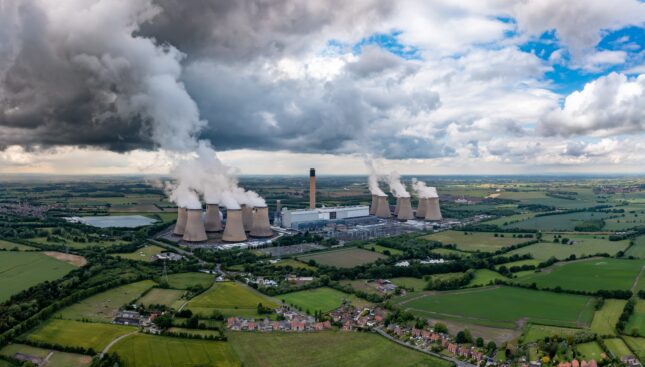-
The 2024 Emissions Gap Report: A Clarion Call for Mandatory Commitments?
November 4, 2024 By Rachel Santarsiero
A new United Nations report calls upon countries to deliver drastically stronger action on climate change. “Emissions Gap Report 2024: No more hot air…please!” is intended to raise the alarm at a significant moment: less than a month before nations head to Azerbaijan for COP29, and just a few months before the preparation and submission of new nationally determined contributions (NDCs) next February ahead of COP30 in Brazil.
UN Environment Programme (UNEP) Executive Director Inger Andersen warns that, while it remains “at least technically possible” to avert the worst of planetary warming, the prospects are increasingly dire: If we’re serious about keeping global temperature rise to 2.0 degrees Celsius, emissions must fall by 28% by 2030. And to stay under 1.5 degrees Celsius? They must drop by 42%.
Since 2010, the UNEP has published its Emissions Gap Report as an independent, science-based assessment to break down the gap between countries’ pledged GHG emission reductions and the emissions reductions needed to align with the goals of the United Nations Framework Convention on Climate Change. (These conventions were first agreed upon as the 2009 Copenhagen Accord, and now, as the 2015 Paris Climate Agreement.)
Under the current Paris climate framework, countries must submit updated NDCs—self-defined national climate pledges—every five years. If this opportunity is used right, the UN says, NDCs can be our way to tackle the climate crisis with “abundant opportunities for accelerating mitigation action,” such as shoring up developments in wind and solar energy.
Falling Badly Short
The bleak reality is that current NDC commitments fall far short of what is needed to reach the 1.5 degrees Celsius target, with a “best-case” scenario of 2.6 degrees of warming this century. Nine G20 countries have set legally binding net-zero targets climate pledges—although they are often based on skewed data in the first place. Yet, collectively, G20 members are set to miss their NDC targets for 2030. And of those countries that have set net zero commitments, their rate of decarbonization would need to accelerate after 2030 to achieve net zero goal by the target year, thus contributing to greater warming overall than if these commitments were frontloaded.
The efficacy of the Paris Agreement hinges on the fact that parties will ratchet up their climate ambition targets to close the emissions gap. Widely supported on both the domestic and industry level, these NDC pledges provide an opportunity for countries to “thoroughly consider and transparently account for their contributions in these global efforts.”
However, when one considers that “only one country has strengthened its target since COP28,” and that the majority of NDCs don’t address transitioning away from fossil fuels, voluntary pledges are perhaps no more than weak instruments that are adopted when political resistance blocks the implementation of more powerful mandatory controls.
Binding or Voluntary: What’s Best?
So, is it time to reimagine a new framework beyond voluntary climate commitments?
Of course, there have been several attempts at implementing legally binding climate treaties in the past, such as the 1997 Kyoto Protocol. However, after the United States failed to ratify the 1997 Kyoto Protocol, only to see President George W. Bush formally withdraw from it in 2001, mandatory commitments to reduce greenhouse gases have largely been seen as a failure.
For instance, nearly a decade later, in Copenhagen, UN negotiators tried to craft a sequel treaty to Kyoto, the Copenhagen Accord, which would require all countries to make commitments. Again, these talks concluded “with nothing more than a vague resolution and acrimony.”
One shining counterexample to these more recent failures, however, is the 1987 Montreal Protocol on Substances that Deplete the Ozone Layer. As the only UN treaty to be ratified by every country on the planet, the Montreal Protocol has successfully phased out the production of chlorofluorocarbons (CFCs) and other ozone-depleting substances.
Over the last 35 years, the Protocol has also earned the title of “the best accidental climate treaty,” since it has helped prevent between 0.5- and 1-degree Celsius of warming. And this past June, the effectiveness of the Protocol was reaffirmed when a study published in Nature Climate Change concluded that levels of harmful ozone-depleting gases are falling faster than expected.
The Nature study noted that “The Montreal Protocol and its successive amendments have been successful in curbing emissions in ozone-depleting substances and potent greenhouse gases via production/consumption controls.” Lead study author Luke Western from the University of Bristol observed that “we’ve turned the final corner. The road is long ahead still, and we have to keep going, but it’s been a huge global success.”
Lessons from Montreal
We should look to the Montreal Protocol as a model for several reasons. According to treaty negotiator Richard Benedick, the Protocol “boldly established firm target dates for [CFC] emissions reductions, even though the technologies for accomplishing these goals did not yet exist.” It also made special allowances for poorer nations which were allowed to increase CFC use for a period before implementing reductions.
Standing in sharp contrast to today’s political gridlock on climate, the Montreal Protocol even notably marked a time when conservatives like President Ronald Reagan appreciated the need to tackle global environmental challenges, as documented in a recent National Security Archive publication.
One of the Montreal Protocol’s greatest feats was its ability to engage with the chemical industry to phase down the production of CFCs and other ozone-depleting substances and balance economic considerations with environmental ones. International ozone negotiations initially signaled a “death knell” for CFC-producing chemical companies—with billions of dollars in investments related to industries in food, transportation, plastics, electronics, cosmetics, and health care. Yet despite industry’s vigorous denial of the linkage between the degrading ozone layer and growing sales of CFCs, the Alliance for Responsible CFC Policy ultimately concluded that increases in CFCs “would be unacceptable for future generations.”
The chemical industries decided to back the treaty following their substance replacement of CFCs. The Montreal Protocol “wasn’t a call for the end of an industry, it was a call for a reform to the industry, calling for a transition of industry,” says Western. “Large chemical manufacturers were both fueling the change and having that change imposed on them.”
Limits and Ambitions
The usefulness of the Montreal template to current climate target debates may be limited by scope. Reducing fossil fuels is vastly more complicated than phasing out CFCs. In fact, Western is careful to contextualize the positive results of Nature study and the long-term successes of the Montreal Protocol: “They are different policies for different aims and different policies have different problems.”
Nevertheless, one lesson that can be taken from Montreal is that there is no single primary cause for the success of the Protocol. The treaty’s ongoing success relies on nations to undertake complicated cooperation action amidst “ambiguity and imperfect [scientific] knowledge.”
Indeed, the Montreal Protocol has been a flexible, fluid, agreement that continues to incorporate changing climate science and solutions. And regardless of the present-day complications required to effectively wean ourselves off fossil fuels, all nations (and particularly G20 countries) are capable of making difficult decisions to stand up to and hold industry accountable in phasing out fossil fuels and bolstering clean energy development.
The report concludes that the harsh reality is that if countries don’t seriously step up their actions, “the Paris Agreement target of holding global warming to 1.5 degrees C will be dead within a few years and 2 degrees C will take its place in the intensive care unit.”
Rachel Santarsiero is the Director of the National Security Archive’s Climate Change Transparency Project in Washington, D.C. The views expressed in this article are the author’s own.
Sources: Eos; National Security Archive; Nature; New York Times; UNEP; Vox
Photo credit: An aerial landscape view of Power Station in North Yorkshire, courtesy of Clare Louise Jackson/Shutterstock.com.
 A Publication of the Stimson Center.
A Publication of the Stimson Center.







